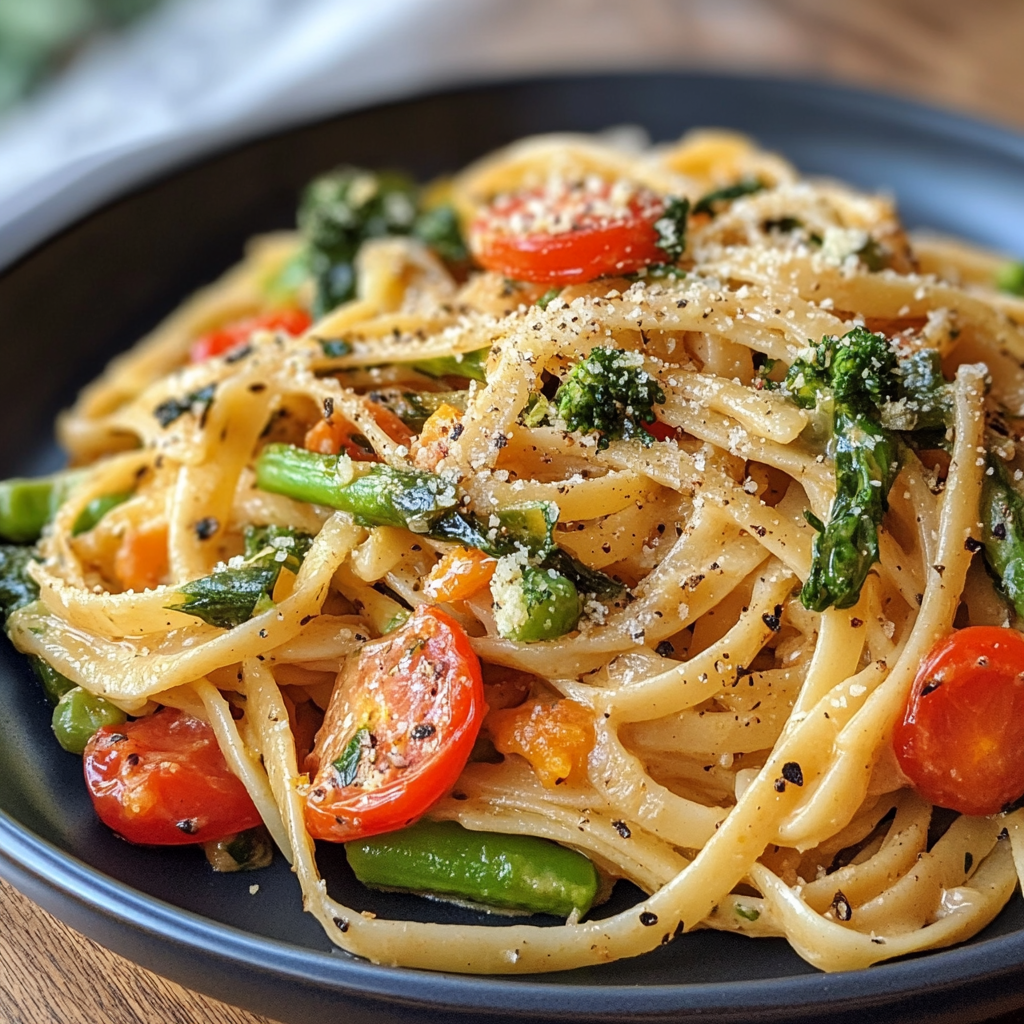Ingredients:
For the Pasta:
- 12 oz (340g) pasta (such as penne, spaghetti, or fettuccine)
- Salt, for pasta water
For the Vegetables:
- 2 tablespoons olive oil
- 1 medium zucchini, sliced into half-moons
- 1 yellow squash, sliced into half-moons
- 1 cup cherry tomatoes, halved
- 1 bell pepper, sliced into strips (use red, yellow, or orange for color)
- 1 cup broccoli florets (or asparagus for a different flavor)
- 1/2 cup frozen peas (optional, for extra color and sweetness)
- 2 cloves garlic, minced
- 1 small onion, thinly sliced
- Salt and freshly ground black pepper, to taste
For the Sauce:
- 3 tablespoons olive oil
- 1/4 cup fresh lemon juice (about 1 lemon)
- Zest of 1 lemon
- 1/2 teaspoon garlic powder
- 1/4 teaspoon red pepper flakes (optional, for heat)
- 1/2 cup freshly grated Parmesan cheese (or vegan Parmesan for a dairy-free version)
- 1/4 cup fresh basil, chopped (or parsley for garnish)
For Garnish:
- Freshly grated Parmesan cheese (optional)
- Lemon wedges, for serving
- Fresh basil leaves, for garnish
Instructions:
1. Cook the Pasta:
Boil the Pasta: Bring a large pot of salted water to a boil. Add the pasta and cook according to the package instructions until al dente, about 9-11 minutes. Stir occasionally to prevent sticking.
Reserve Pasta Water: Before draining the pasta, reserve about 1/2 cup of the pasta water. This starchy water will help bring the sauce together and make it creamier.
Drain the Pasta: Drain the pasta and set it aside. You can toss it with a little olive oil to prevent it from sticking while you prepare the vegetables.
2. Sauté the Vegetables:
Heat the Olive Oil: In a large skillet or sauté pan, heat 2 tablespoons of olive oil over medium heat. Once hot, add the sliced zucchini and yellow squash. Sauté for about 3-4 minutes until they begin to soften but still retain some texture.
Add the Other Vegetables: Add the cherry tomatoes, bell pepper, broccoli florets (or asparagus), and frozen peas (if using). Sauté the vegetables for another 5-7 minutes, stirring occasionally, until they are tender but still crisp. If the vegetables start to brown too quickly, you can add a splash of water to the pan to help them steam.
Sauté the Garlic and Onion: Add the sliced onion and minced garlic to the pan with the vegetables. Cook for another 2-3 minutes until the garlic becomes fragrant and the onions soften. Season the vegetables with salt and freshly ground black pepper to taste.
3. Prepare the Sauce:
Make the Sauce: In a small bowl, whisk together 3 tablespoons of olive oil, lemon juice, lemon zest, garlic powder, and red pepper flakes (if using). Stir until well combined. The sauce will be light and refreshing, with the lemon brightening up the flavors of the vegetables.
4. Combine the Pasta and Vegetables:
Toss Everything Together: Add the cooked pasta to the skillet with the sautéed vegetables. Pour the lemon sauce over the pasta and vegetables and toss everything together gently to combine. If the mixture seems a little dry, add some of the reserved pasta water to help loosen it up and create a silky sauce that coats the pasta.
Add Parmesan: Once the pasta and vegetables are well coated with the sauce, stir in the freshly grated Parmesan cheese (or vegan Parmesan for a dairy-free version). The cheese will melt into the sauce, making it creamy and flavorful. If you prefer a vegan option, you can skip the cheese or use a dairy-free alternative.
5. Serve:
Plate the Dish: Serve the pasta primavera in bowls or on plates. Garnish with additional Parmesan cheese, fresh basil leaves, and a squeeze of lemon juice for extra brightness.
Optional Toppings: For extra flavor, sprinkle some crushed red pepper flakes on top for a bit of heat, or add a drizzle of extra virgin olive oil for richness.
Serving Suggestions:
- With a Side Salad: Serve the pasta primavera with a side of mixed greens or a light Italian salad for added freshness. A simple balsamic vinaigrette would be a perfect pairing.
- With Garlic Bread: For a more indulgent meal, serve the pasta with crispy garlic bread or toasted baguette slices to soak up the extra sauce.
- With Grilled Protein: If you want to add protein to the meal, try serving it with grilled chicken, tofu, or even a sprinkle of chickpeas for a plant-based option.
Tips for the Perfect Vegetarian Pasta Primavera:
- Use Seasonal Vegetables: Pasta primavera is all about fresh, seasonal vegetables. Feel free to customize this recipe depending on what vegetables are available. Asparagus, peas, spinach, or even artichokes would be great additions. Use what’s in season for the best flavor.
- Customize the Spice Level: If you prefer a bit more spice, you can increase the amount of red pepper flakes or even add a small diced jalapeño to the sautéed vegetables. For a milder version, skip the red pepper flakes altogether.
- Make It Lighter: To lighten up this dish, skip the cheese and go for a sprinkle of nutritional yeast for a cheesy flavor without the dairy. You can also reduce the olive oil and skip the butter, using vegetable broth to sauté the vegetables instead.
- Use Whole Wheat or Gluten-Free Pasta: To make the dish healthier or suit dietary preferences, swap the regular pasta with whole wheat or gluten-free pasta. Both options will work beautifully with the vegetables and sauce.
- Make It Vegan: This dish is naturally vegetarian, but if you’re following a vegan diet, simply replace the Parmesan with a vegan cheese alternative or use nutritional yeast for a similar cheesy taste. The sauce is already vegan-friendly with olive oil and lemon, so it’s easy to adjust.
Storage and Reheating:
Storing Leftovers: If you have leftovers, store them in an airtight container in the fridge for up to 3 days. The pasta and vegetables will keep well, though the texture of the zucchini and squash may soften more upon reheating.
Reheating: To reheat, you can use the microwave, heating in 30-second intervals and stirring in between, or reheat in a skillet over medium-low heat. If the pasta has dried out, add a little splash of water or vegetable broth to loosen the sauce.
Final Thoughts:
Vegetarian Pasta Primavera is a colorful, nutritious, and incredibly versatile dish that can be customized to suit your tastes. The combination of fresh vegetables, light lemon sauce, and perfectly cooked pasta creates a satisfying meal that feels fresh and vibrant. It’s easy to make, full of flavor, and a great way to enjoy the bounty of seasonal produce. Whether you serve it as a main dish or a side, this pasta primavera will be a hit with vegetarians and non-vegetarians alike! Enjoy this healthy, light, and flavorful pasta dish for lunch, dinner, or even as a meal prep option for the week ahead!

